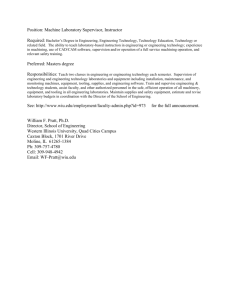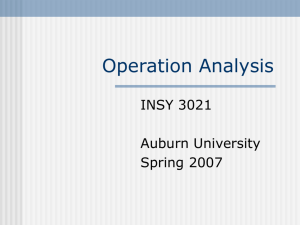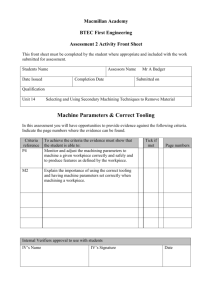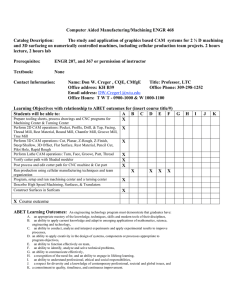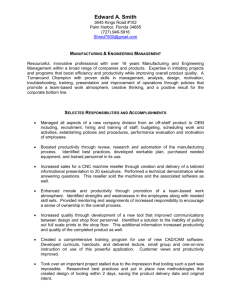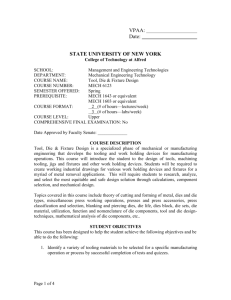Sinclair Community College
advertisement
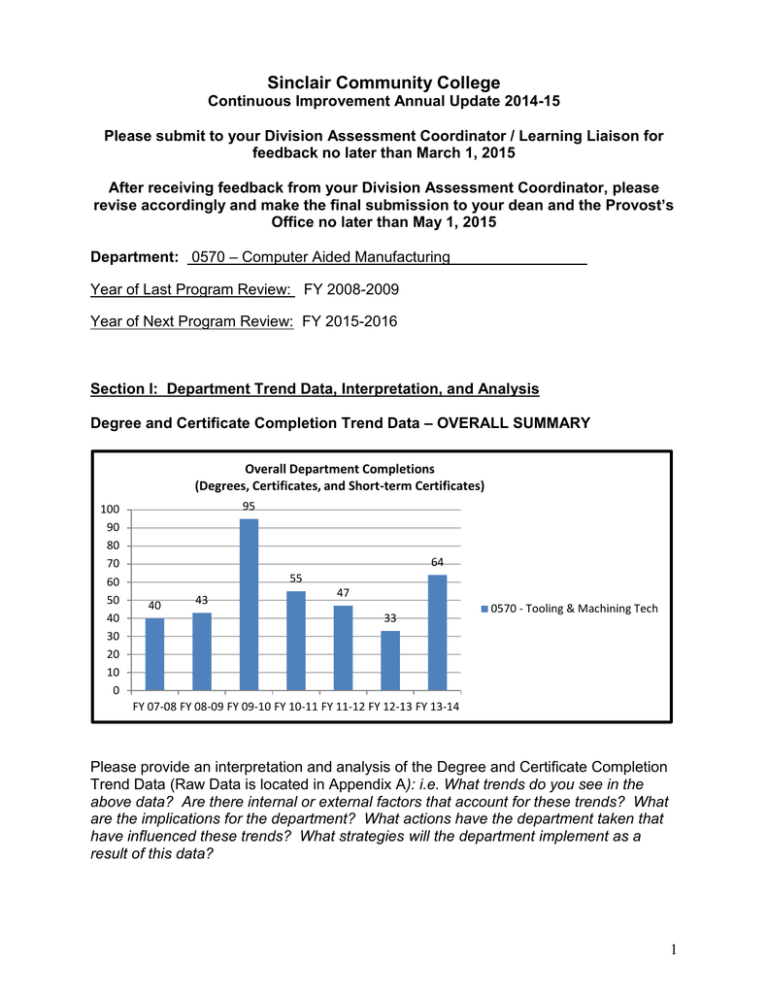
Sinclair Community College Continuous Improvement Annual Update 2014-15 Please submit to your Division Assessment Coordinator / Learning Liaison for feedback no later than March 1, 2015 After receiving feedback from your Division Assessment Coordinator, please revise accordingly and make the final submission to your dean and the Provost’s Office no later than May 1, 2015 Department: 0570 – Computer Aided Manufacturing Year of Last Program Review: FY 2008-2009 Year of Next Program Review: FY 2015-2016 Section I: Department Trend Data, Interpretation, and Analysis Degree and Certificate Completion Trend Data – OVERALL SUMMARY Overall Department Completions (Degrees, Certificates, and Short-term Certificates) 100 90 80 70 60 50 40 30 20 10 0 95 64 55 40 43 47 33 0570 - Tooling & Machining Tech FY 07-08 FY 08-09 FY 09-10 FY 10-11 FY 11-12 FY 12-13 FY 13-14 Please provide an interpretation and analysis of the Degree and Certificate Completion Trend Data (Raw Data is located in Appendix A): i.e. What trends do you see in the above data? Are there internal or external factors that account for these trends? What are the implications for the department? What actions have the department taken that have influenced these trends? What strategies will the department implement as a result of this data? 1 Completion Trends The Computer Aided Manufacturing (CAM) department has seen a significant increase in the number of completions. This major increase follows three straight years of decreasing numbers. The FY 13-14 completions (64) are almost double the number of completions in the previous year (33 in FY 12-13). The FY 13-14 completions is the second highest number in the past seven years, with the highest (95 in FY 09-10) representing the major push for completions prior to the semester conversion. The CAM department is optimistic that the strong numbers in FY 13-14 are indicative of the improving health of the manufacturing environment and that we will see sustained numbers in the near future. This dramatic increase in completions can be attributed to one external factor and one internal factor. Externally, we have seen an increase in the regional manufacturing activity of employers. Internally, we have seen an increase in the popularity of the Computer Numerical Control (CNC) Technology short-term certificate. Externally, we note that manufacturing is typically cyclical by nature. After a slow period, characterized by off-shoring and layoffs, the region’s manufacturing industry has bounced back. Many local manufacturers have reported “reshoring” or bringing back much of the work that had initially been sent overseas. Employers are once again hiring and investing in new technology. Much of this information comes from our partnership with the Dayton Regional Manufacturers Association (DRMA) which monitors the health of local manufacturing. Looking at leading indicators, we knew the completion numbers would increase. Increased manufacturing activity leads to increased enrollment, which we saw in 2012. Increased enrollment leads to increased completion, which we see in these Annual Update numbers. Internally, we have seen an increase in the popularity of the CNC Technology shortterm certificate. It’s a relatively new certificate and we’ve recently revised some of the courses. CNC Technology represents the cutting edge of manufacturing technology and we’re seeing many experienced machinists coming to Sinclair to learn this new technology, as they see more and more CNC job openings. Another factor contributing to the increase in CAM enrollment and completions is the constant effort that the CAM department has put forth in the area of outreach. The CAM department has always been part of high school events, college nights, Tech Prep events, and manufacturing-related SkillsUSA competitions. These efforts result in Sinclair being known as a high quality provider of advanced manufacturing instruction. Looking deeper at the numbers, the two biggest components of CAM’s completions are the STEP II Precision Machining certificate and the CNC Technology short-term 2 certificate. The table below shows the significant increase in the FY 13-14 numbers that are reflected in the overall numbers. Completions FY 10-11 FY 11-12 FY 12-13 FY 13-14 STEP II Cert. (CAMPS) 16 12 10 20 CNC Tech. STC (CNC) 22 17 17 30 Course Success Trend Data – OVERALL SUMMARY Overall Department Success Rates 100.0% 80.0% 78.2% 81.5% 75.2% 69.8% 74.3% 78.6% 80.1% 60.0% 0570 - Tooling & Machining Tech SME 40.0% COLLEGEWIDE 20.0% 0.0% FY 07-08 FY 08-09 FY 09-10 FY 10-11FY 11-12 FY 12-13 FY 13-14 Please provide an interpretation and analysis of the Course Success Trend Data (Raw Data is located in Appendix A). Looking at the success rate data provided in the Appendix for each course, please discuss trends for high enrollment courses, courses used extensively by other departments, and courses where there have been substantial changes in success. Success Trends The CAM department has maintained strong numbers in terms of success rates, consistently scoring above the division and college wide averages. The department’s 3 success rates have been trending upward, increasing constantly from 69.8% in FY 1011 to the latest 80.1% in FY 13-14. The highest enrollment courses in CAM are typically CAM 1107 (Principles of Manufacturing) and CAM 1109 (Fundamentals of Tooling and Machining). CAM 1109 has spent the last three years in the 80 percents, which is promising. CAM 1109 is utilized by the Automotive programs, so increased scrutiny is warranted. CAM 1107 has produced lower numbers, with the last three years being 51.5%, 64.0%, and 68.8%. CAM 1107 involved the use of computers, and many CAM students were struggling with basic computer literacy. To address this, a few years ago the CAM department placed a prerequisite of MET 1131 (PC Applications for Engineering Technology) on CAM 1107. The last three years of success data show a steady increase. We will continue to monitor the situation, especially since it is one of our higher enrollment courses. Another course to watch will be CAM 1116 (Fundamentals of CNC Operations). CAM 1116 is a new course as of the fall semester of 2014. It is already one of CAM’s most popular courses, so we will want to keep an eye on it. The course replaces CAM 1213 (Fundamentals of CNC Control) which had some problems in terms of scope and content. These problems were reflected in declining success rates, going from 78% to 67% after the semester conversion. CAM 2204 (CNC Lathe Programming) is one course that has shown a decrease in success rates. Since the semester conversion, it went from 85.3% to 76.8%. CNC Lathe programming is especially difficult in that it requires a different reference system and different way of thinking than typical mill programming. So CAM 2204 is a difficult course. While 76.8% is a reasonable success rate, we will continue to monitor the results to make sure that a downward trend does not develop. Please provide any additional data and analysis that illustrates what is going on in the department (examples might include accreditation data, program data, benchmark data from national exams, course sequence completion, retention, demographic data, data on placement of graduates, graduate survey data, etc.) Additional Analysis The most popular program in the CAM department is the STEP II Precision Machining certificate, which has been around for over 30 years and enjoys an outstanding reputation among regional employers. Many companies seek out the STEP II graduates, and some companies like UTC Aerospace Systems in Troy hire STEP II graduates exclusively for certain programs. Several years ago, the STEP II program incorporated an internship as an elective. Not all student take advantage of the internship option – some do not qualify academically, some do not want to delay their graduation, and some are working already. But for many students, the STEP II 4 internship is an excellent way for them to learn the real-world aspects of being a precision machinist, while earning good money and getting a foot in the door at a potential employer. In terms of measuring the local support and interest among local employers for Sinclair’s STEP II program, consider the inaugural STEP II Internship Meet & Greet that we held in October of 2014. 40 representatives from 30 different companies came to Sinclair to meet 19 prospective interns for the spring semester of 2015. This overwhelming employer response shows validation of the quality of the STEP II program. Roughly half of the STEP II students elect to do the internship in the spring semester. While we do not expect all students to intern, it is an important option for many of our students. The chart below shows recent STEP II data. Spring 2014 Spring 2015 12 (46%) 15 (52%) STEP II students not interning 14 14 Total STEP II students 26 29 STEP II students interning 5 Section II: Progress Since the Most Recent Review Below are the goals from Section IV part E of your last Program Review Self-Study. Describe progress or changes made toward meeting each goal over the last year. GOALS Distance Learning: The CAM department is exploring distance learning opportunities for some of its manufacturing courses. It may be possible to incorporate some of the web material from Haas Automation. Course enhancements, and hybrids are being considered as well as full web courses. 4 and 5 Axis Machining: The new Haas CNC machines give us the added capability of 4 and 5 axis programming and machining. The CAM department is beginning to explore how this technology can be incorporated into the curriculum. Tabletop Simulators: Our new Haas tabletop control simulators may allow us to offer CNC programming courses in different locations. Status In progress Completed No longer applicable Progress or Rationale for No Longer Applicable New update, changing from “no longer applicable” to “in progress.” Sinclair is part of al eleven college consortium that received a TAACCCT grant from the Department of Labor. This grant created the Ohio TechNet. As part of the grant, the Sinclair CAM department is putting the Basic Machining Skills Certificate (6 courses) in a hybrid delivery format with competency-based curriculum, similar to the AccelerateIT program. Development began in spring of 2015. In progress Completed This topic is still being discussed, but the top priority has been given to the Ohio TechNet grant mentioned above. No longer applicable In progress Completed Table top simulators have not proven to be as portable as we would have liked, but we have had Ponitz acquire some of these so this course could be offered there. Also, the Preble County Learning Center has acquired some table top simulators which brings new capabilities to that area. 6 No longer applicable Bio-Manufacturing: We will explore opportunities in the emerging fields of biomanufacturing and medical devices. In progress Completed No longer applicable Our students are already getting jobs in these fields and it is questionable whether a high level 5 axis course would be of great value. This will track with the 4 and 5 axis classes discussed above. 7 Below are the Recommendations for Action made by the review team. Describe the progress or changes made toward meeting each recommendation over the last year. RECOMMENDATIONS The department could consider developing additional methods of recruiting students, including use of the web-site and possibly forming partnerships with career technical programs. There is a need to build adjunct faculty ranks to manage projected enrollment growth, and the department should develop strategies that will facilitate this process. If there is a threat posed by emerging competition from forprofit organizations and career technology centers, the department should seek ways to publicly differentiate the Sinclair program and what it has to offer from others. Status In progress Completed No longer applicable Progress or Rationale for No Longer Applicable We are working with industry partners to develop recruitment strategies which include work-study and scholarships. We are also working with tech prep to offer some “Y” credits to students who have completed selected high school classes. We are also looking to expand offerings into Warren County and Preble County. We purchased a table-top mill that can be used for outreach. In progress Completed No longer applicable We added one new adjunct faculty member in fall of 2014 and we have two good candidates for fall of 2015. We hope to have the candidates sit in on some classes over the summer. In progress Completed No longer applicable We continue to do this by utilizing our HAAS connection, our partnerships with Tech Prep High schools and industry partners. The fact that we now offer the co-op program for STEP II has a huge impact on our industry partners and our planned initiatives with both UTC and GE will give us a strategic advantage that none of our competition has. It is significant that they both approached us with these initiatives. The fact that we also host the State of Ohio SKILLS USA Precision Machining and CNC programming competition also separates us from our competition. 8 The faculty is encouraged to consider alternative delivery strategies, e.g. non-credit courses and short-term certificates, to meet the community’s need for workforce development and to plan future approaches to meeting needs related to new applications in areas such as biomanufacturing and manufacturing of medical devices. In progress Completed No longer applicable While it is clear that excellent In progress learning experiences designed to facilitate the achievement of general education outcomes as Completed well as program outcomes are in place, there is no documented No longer applicable evidence that those outcomes are being met. If needed, support is available through the College-Wide Assessment Committee to design methods for collecting, analyzing, and documenting data regarding these outcomes. We are working with Workforce Development to develop and deliver classes to the workforce and are in the process of updating and revising both degrees and certificates in our program to shorten completion time. The CNC Short term will now be a two semester rather that a three semester certificate. Additionally, our work with the Ohio TechNet grant will offer alternative delivery methods for the six courses in our Basic Machining Skills certificate. We have identified the outcomes and the assessment methods tied to specific courses. We are in the process of gathering data. We will try to go deeper in our assessment strategies by using more assessment rubrics and specific projects/portfolios tied to specific outcomes. We are particularly interested in using these for the Gen Ed outcomes. 9 Please respond to the following items regarding external program accreditation. Date of most recent accreditation review: _____________ Date of Most Recent Program Accreditation Review OR Programs in this department do not have external accreditation Please describe any issues or recommendations from your last accreditation review (if applicable) Please describe progress made on any issues or recommendations from your last accreditation review (if applicable) Section III: Assessment of General Education & Degree Program Outcomes The Program Outcomes for the degrees are listed below. All program outcomes must be assessed at least once during the 5 year Program Review cycle, and assessment of program outcomes must occur each year. PLEASE NOTE – FOR THE NEXT TWO YEARS, GENERAL EDUCATION OUTCOME ASSESSMENT WILL BE TEMPORARILY POSTPONED. WE WOULD ASK THAT IN THIS ANNUAL UPDATE YOU IDENTIFY AT LEAST ONE COURSE IN YOUR DEGREE PROGRAM(S) WHERE ASSESSEMENT AT THE MASTERY LEVEL WILL OCCUR FOR THE FOLLOWING THREE GENERAL EDUCATION OUTCOMES: CRITICAL THINKING/PROBLEM SOLVING INFORMATION LITERACY COMPUTER LITERACY 10 NOTE THAT THERE WILL NEED TO BE AT LEAST ONE EXAM / ASSIGNMENT / ACTIVITY IN THIS COURSE THAT CAN BE USED TO ASSESS MASTERY OF THE COMPETENCY. YOU MAY ALSO SUBMIT ASSESSMENT RESULTS FOR THESE GENERAL EDUCATION COMPETENCIES IF YOU HAVE THEM, BUT IT WILL BE CONSIDERED OPTIONAL. To which degree(s) is this program outcome related? Year courses identified where mastery of general education competency will be assessed. Critical Thinking/Problem Solving All programs 2014-2015 CAM 2780 Information Literacy Computer Literacy Values/Citizenship/Community Oral Communication Written Communication All programs All programs All programs All programs All programs 2014-2015 2014-2015 2015-2016 N/A N/A CAM 2780 CAM 2212 Due in FY 2015-16 COM 2206/2211 ENG 1101 General Education Outcomes Are changes planned as a result of the assessment of general education outcomes? If so, what are those changes How will you determine whether those changes had an impact? PLEASE INDICATE AT LEAST ONE COURSE WHERE MASTERY OF THE COMPETENCY WILL BE ASSESSED FOR EACH OF YOUR DEGREE PROGRAMS What were the assessment results for this General Education competency? (Please provide brief summary data) NOTE: - THIS IS OPTIONAL FOR THE FY 2014-15 AND FY 2015-16 ANNUAL UPDATES OPTIONAL FOR FY 2014-15 OPTIONAL FOR FY 2014-15 11 12 Program Outcomes To which course(s) is this program outcome related? Year assessed or to be assessed. 2012-2013 Demonstrate technical engineering skills appropriate to program requirements. Assessment Methods Used Simulations Performanc e appraisals Simulations Performanc e appraisals Exams CAM 1109,1213,21 45,2204,2212, 2214,2780 2012-2013 Analyze manufacturing engineering problems (general and technical) and make appropriate decisions. CAM 1107, 2145,2204,22 12,2213,2214, OPT 1100, MET 1131, OPT 2240 Demonstrate mathematical skills required for occupation. CAM 1141,1142 What were the assessment results? (Please provide brief summary data) We are in the process of tying outcomes to assessment measures more specifically using the model developed for OPT in their ETAC/ABET Assessment. We are not yet at that point due to the personnel changes made in the department the last year.. However, using the results of the classes CAM 1109, 1213,2145, 2204,2212,and 2780 80% of the students scored above a “C” on the tests and projects. In this area, the only course that caused some concern was CAM 1107 where only 65% of the students were successful. All the other courses had 80% of students get a “C” or better in Assessment methods mentioned in the previous column. 2014-15 Locally Developed Exams – Using the In the fall semester of 2014/2015, 70% of CAM students scored “C” or 13 CAM 1141 and 1142 tests, at least 80% of the students will score C or better on the tests. Since the courses are Shop Floor Calculations I and II, all test questions are related to mathematical skills. 2015-16 Exams Performanc e Appraisals Employer feedback better on the tests in CAM 1141 and 1142. This is lower than we’d like to see, and the department is looking into it. On the other hand, 84% of CAM 1141 and 1142 students received a course grade of “C” or better. Identify new changes in career field and build personal skills to maintain state-of-the-art competencies. CAM 2212,2213,22 14, COM 2206, OTM SOC, OTM Art/HUM, SCC 1101, ENG 1101 Demonstrate applied competencies in the areas of machining applications, drafting techniques and blueprint interpretation. CAM 1107,2114,22 12,2213,2214, 2225, OPT 1113 Are changes planned as a result of the assessment of program outcomes? If so, what are those changes? The assessment of the Mathematics program outcome showed 70% of students scoring a “C” or better on the tests in CAM 1141 and 1142. The CAM department will be discussing possible changes to improve student performance. 2016-17 Performanc e Appraisals In process of designing methods to capture data more directly tied to outcome, i.e. specific questions on exams or a rubric that would list or tie to the outcome. In process of designing methods to capture data more directly tied to outcome, i.e. specific questions on exams or a rubric that would list or tie to the outcome. 14 How will you determine We will continue to monitor the test performance of the CAM 1141 and 1142 students. whether those changes had an impact? 15 APPENDIX – PROGRAM COMPLETION AND SUCCESS RATE DATA Degree and Certificate Completion Division Department Department Name Program SME SME SME SME SME SME SME SME SME SME SME SME SME SME SME SME SME SME 0570 0570 0570 0570 0570 0570 0570 0570 0570 0570 0570 0570 0570 0570 0570 0570 0570 0570 CAMCT.AAS CAMCT.S.AAS CAMPM.AAS CAMPM.S.AAS CAMPS.CRT CAMPS.S.CRT CAMTD.CRT CNC.S.STC CNC.STC CTGMA.STC IDMT.STC MO.AAS TD.CRT TGMA.STC TMO.AAS TMTMT.AAS TMTPS.CRT TMTTD.CRT Tooling & Machining Tech Tooling & Machining Tech Tooling & Machining Tech Tooling & Machining Tech Tooling & Machining Tech Tooling & Machining Tech Tooling & Machining Tech Tooling & Machining Tech Tooling & Machining Tech Tooling & Machining Tech Tooling & Machining Tech Tooling & Machining Tech Tooling & Machining Tech Tooling & Machining Tech Tooling & Machining Tech Tooling & Machining Tech Tooling & Machining Tech Tooling & Machining Tech FY 07-08 FY 08-09 FY 09-10 FY 10-11 FY 11-12 FY 12-13 FY 13-14 . . 5 . 3 . . . . . 1 . . 4 2 6 18 1 4 . 1 . 20 . 1 . . 7 . 1 2 . . 4 3 . 6 . 13 . 42 . 3 . 24 . . . 2 . 1 3 1 . 9 . 6 . 16 . . . 22 . . . . . . . 1 1 10 . 7 . 12 . . . 17 . . . . . . 1 . . 1 3 1 . 4 7 . 7 10 . . . . . . . . . 1 8 . 4 1 19 . 25 5 . . . . . . . 1 . Course Success Rates Department Department Name Course 0570 Tooling & Machining Tech CAM-1107 FY 0708 FY 0809 FY 0910 . . . FY 10- FY 11-12 11 . . FY 1213 FY 1314 64.0% 68.8% 16 0570 0570 0570 0570 0570 0570 0570 0570 0570 0570 0570 0570 0570 0570 0570 0570 0570 0570 0570 0570 0570 0570 0570 0570 0570 0570 0570 0570 0570 0570 0570 Tooling & Machining Tech Tooling & Machining Tech Tooling & Machining Tech Tooling & Machining Tech Tooling & Machining Tech Tooling & Machining Tech Tooling & Machining Tech Tooling & Machining Tech Tooling & Machining Tech Tooling & Machining Tech Tooling & Machining Tech Tooling & Machining Tech Tooling & Machining Tech Tooling & Machining Tech Tooling & Machining Tech Tooling & Machining Tech Tooling & Machining Tech Tooling & Machining Tech Tooling & Machining Tech Tooling & Machining Tech Tooling & Machining Tech Tooling & Machining Tech Tooling & Machining Tech Tooling & Machining Tech Tooling & Machining Tech Tooling & Machining Tech Tooling & Machining Tech Tooling & Machining Tech Tooling & Machining Tech Tooling & Machining Tech Tooling & Machining Tech CAM-1109 CAM-1141 CAM-1142 CAM-1161 CAM-1162 CAM-1213 CAM-2114 CAM-2145 CAM-2204 CAM-2212 CAM-2225 CAM-2297 CAM-2700 CAM-2780 INT-107 INT-109 INT-113 INT-114 INT-116 INT-131 INT-141 INT-142 INT-143 INT-145 INT-161 INT-162 INT-163 INT-204 INT-211 INT-212 INT-213 . . . . . . . . . . . . . . . . . . . . . . . . . . . . . . . . . . . . . . . . . . . . . . . . . . . . . . . . . . 36.4% 43.9% 73.0% 72.5% 70.4% 64.2% 76.4% 78.2% 78.4% 65.1% 54.2% 51.7% 52.9% 43.8% 95.2% 100.0% 85.5% 74.7% 83.3% 61.5% 70.0% . 74.9% 84.3% 73.1% 76.1% 84.4% 84.1% 79.1% 80.0% 88.9% 92.0% 94.4% 85.2% 68.0% 73.5% 87.9% 66.7% 75.5% 78.4% 54.0% 67.6% 52.2% 86.7% 78.3% 61.9% 87.0% 87.1% 100.0% 87.5% 100.0% 89.7% 82.1% 84.8% 93.2% 95.2% 81.6% 73.2% 69.0% 87.0% 75.0% 83.3% 93.3% 100.0% 90.0% 100.0% . . . . . . . . . . . . . . 51.5% 78.4% 66.3% 45.5% 86.8% . 75.7% 71.9% 88.9% 76.5% 69.6% 82.4% 90.5% 60.5% 83.3% 94.4% 92.9% 83.1% 87.8% 73.5% 74.4% 75.9% 78.0% 57.1% 71.9% 85.3% 81.8% 54.5% 96.3% . 81.8% . 88.6% . . . . 100.0% . 100.0% 71.4% . . . . 72.7% . . 87.6% 81.0% 80.6% 81.1% 75.0% 67.1% 64.3% 88.2% 76.8% 80.8% 68.8% 100.0% 89.7% 100.0% . . . . . . . . . . . . . . . . . 17 0570 0570 0570 0570 0570 Tooling & Machining Tech Tooling & Machining Tech Tooling & Machining Tech Tooling & Machining Tech Tooling & Machining Tech INT-225 INT-226 INT-227 INT-270 INT-297 62.5% 71.4% 72.7% 100.0% . . 66.7% 100.0% . 94.1% 94.6% 100.0% 94.7% 91.9% 100.0% 80.0% . . 83.3% 90.0% 50.0% . . 50.0% 100.0% . . . . . . . . . . 18
